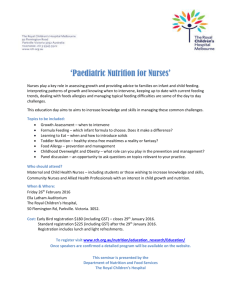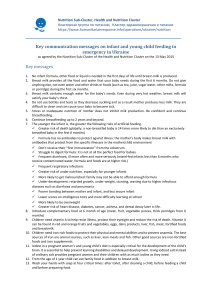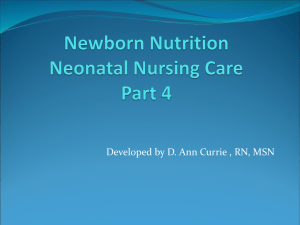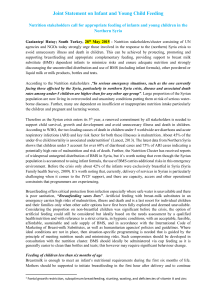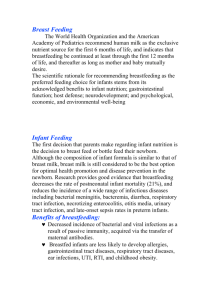Press release
advertisement
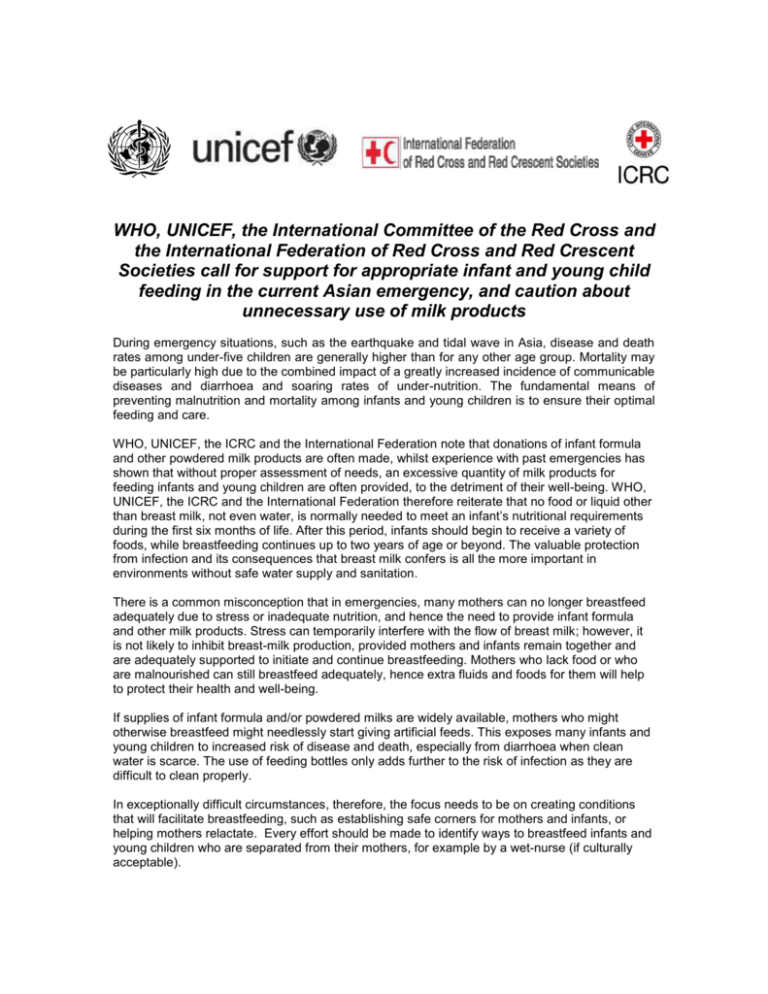
WHO, UNICEF, the International Committee of the Red Cross and the International Federation of Red Cross and Red Crescent Societies call for support for appropriate infant and young child feeding in the current Asian emergency, and caution about unnecessary use of milk products During emergency situations, such as the earthquake and tidal wave in Asia, disease and death rates among under-five children are generally higher than for any other age group. Mortality may be particularly high due to the combined impact of a greatly increased incidence of communicable diseases and diarrhoea and soaring rates of under-nutrition. The fundamental means of preventing malnutrition and mortality among infants and young children is to ensure their optimal feeding and care. WHO, UNICEF, the ICRC and the International Federation note that donations of infant formula and other powdered milk products are often made, whilst experience with past emergencies has shown that without proper assessment of needs, an excessive quantity of milk products for feeding infants and young children are often provided, to the detriment of their well-being. WHO, UNICEF, the ICRC and the International Federation therefore reiterate that no food or liquid other than breast milk, not even water, is normally needed to meet an infant’s nutritional requirements during the first six months of life. After this period, infants should begin to receive a variety of foods, while breastfeeding continues up to two years of age or beyond. The valuable protection from infection and its consequences that breast milk confers is all the more important in environments without safe water supply and sanitation. There is a common misconception that in emergencies, many mothers can no longer breastfeed adequately due to stress or inadequate nutrition, and hence the need to provide infant formula and other milk products. Stress can temporarily interfere with the flow of breast milk; however, it is not likely to inhibit breast-milk production, provided mothers and infants remain together and are adequately supported to initiate and continue breastfeeding. Mothers who lack food or who are malnourished can still breastfeed adequately, hence extra fluids and foods for them will help to protect their health and well-being. If supplies of infant formula and/or powdered milks are widely available, mothers who might otherwise breastfeed might needlessly start giving artificial feeds. This exposes many infants and young children to increased risk of disease and death, especially from diarrhoea when clean water is scarce. The use of feeding bottles only adds further to the risk of infection as they are difficult to clean properly. In exceptionally difficult circumstances, therefore, the focus needs to be on creating conditions that will facilitate breastfeeding, such as establishing safe corners for mothers and infants, or helping mothers relactate. Every effort should be made to identify ways to breastfeed infants and young children who are separated from their mothers, for example by a wet-nurse (if culturally acceptable). For these reasons, any provision of breast-milk substitutes for feeding infants and young children should be based on careful assessment of needs. These products should be used only under strict medical control and monitoring and in hygienic conditions, in accordance with the International Code of Marketing of Breast-milk Substitutes and subsequent relevant World Health Assembly resolutions, as well as humanitarian agencies' policies and guidelines. There should be no general distribution. If donations have been given in a country, they can be mixed with a milled fortified staple for distribution as a complementary food to make porridge for children over 6 months of age. For treatment of children who are severely malnourished, milk-based therapeutic foods are needed to be used by specialized agencies and trained personnel following strict protocols and ensuring close supervision. Standard commercial infant formulas are not suitable for this purpose. Children from the age of six months require nutrient-rich complementary foods in addition to breastfeeding. Provision of fortified foods or micronutrient supplements such as vitamin A or zinc in supervised programmes for young children represent a much more appropriate form of food aid than sending milk products. In rations for general food distribution programmes, protein sources such as pulses, meat, or fish are preferred to powdered milk. WHO, UNICEF, the ICRC and the International Federation urge all who are involved in the provision of emergency supplies to refer to the extensive guidance available on this topic. Related publications and documents Infant and young child feeding 1. Guiding principles for feeding infants and young children during emergencies. Geneva, World Health Organization, 2004 Full text in English 2. http://whqlibdoc.who.int/hq/2004/9241546069.pdf Infant feeding in emergencies. Training modules, UNHCR/UNICEF/WFP/WHO/LINKAGES/IBFAN/GIFA. (draft version) Module 1 http://www.ennonline.net/ife/module1/index.html Module 2 http://www.ennonline.net/ife/module2/index.html 3. Guiding Principles for Complementary Feeding of the Breastfed Child. PAHO/WHO, Division of Health Promotion and Protection/Food and Nutrition Program, Washington, DC, USA, 2003. Full text in English http://www.who.int/child-adolescenthealth/New_Publications/NUTRITION/guiding_principles.pdf 4. Feeding the non-breastfed child 6-24 months age. WHO/FCH/CAH/04.13 Full text in English http://www.who.int/child-adolescenthealth/New_Publications/NUTRITION/WHO_FCH_CAH_04.13.pdf 5. Management of severe malnutrition: a manual for physicians and other senior health workers. Geneva, World Health Organization, 1999. Full text in English http://www.who.int/nut/documents/manage_severe_malnutrition_eng.pdf 6. International Code of Marketing of Breast-milk Substitutes Full text in English http://www.who.int/nut/documents/code_english.PDF 7. Relactation: A review of experience and recommendations for practice Full text in English http://www.who.int/child-adolescenthealth/New_Publications/NUTRITION/Relactation_EN.html 8. Feeding in Exceptionally Difficult Circumstances Full text in English http://www.who.int/child-adolescent-health/NUTRITION/difficult_circumstances.htm 9. Red Cross nutrition policies and policy on the use of artificial milks in relief actions Available in English from the ICRC or the International Federation. Available in French in « Manuel de Nutrition pour l’Intervention Humanitaire » Full text in French http://www.icrc.org/Web/Eng/siteeng0.nsf/htmlall/section_publications_assistance Related Links WHO website on earthquake and tsunami emergency http://www.who.int/hac/crises/international/asia_tsunami/en/ Department of Nutrition for Health and Development, WHO, website http://www.who.int/nut/ Department of Child and Adolescent Health and Development, WHO, website http://www.who.int/child-adolescent-health/nut.htm UNICEF Website on breastfeeding and complementary feeding http://www.unicef.org/nutrition/index_breastfeeding.html UNICEF website on emergencies and nutrition http://www.unicef.org/nutrition/index_emergencies.html For further information, contact: Susie Villeneuve, Project Officer, Nutrition Programme Division, UNICEF Email: svilleneuve@unicef.org Miriam Labbok, MD, Senior Advisor, Infant and Young Child Feeding Programme Division, UNICEF Email: mlabbok@unicef.org André Briend - Medical Officer Department of Child and Adolescent Health and Development Email: brienda@who.int Randa Saadeh - Scientist Nutrition for Health and Development Email: saadehr@who.int
